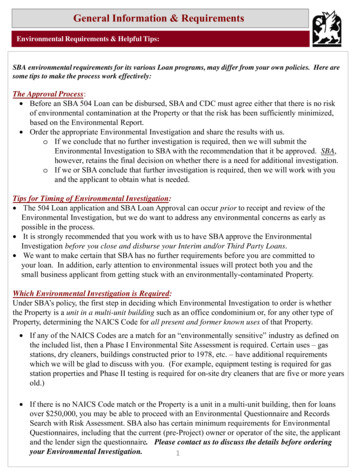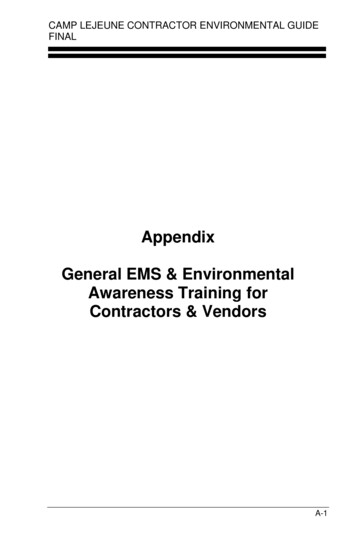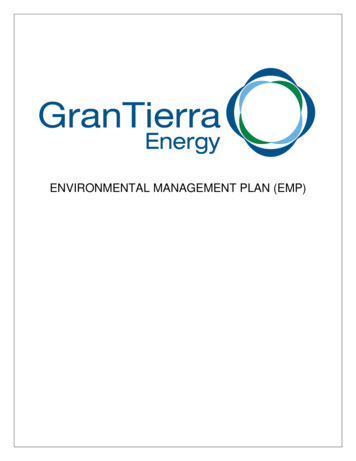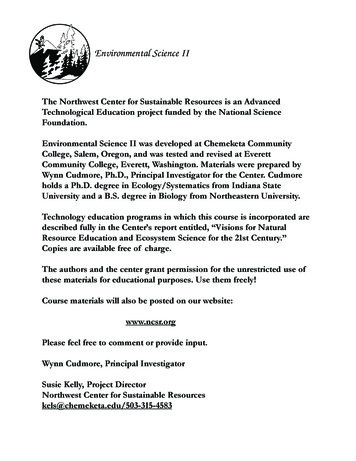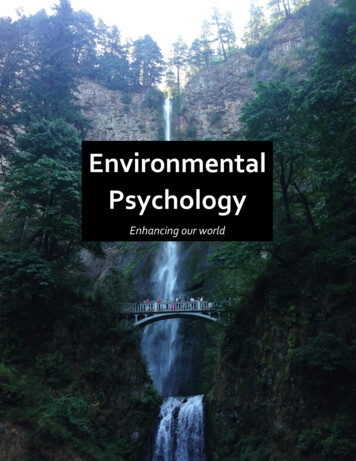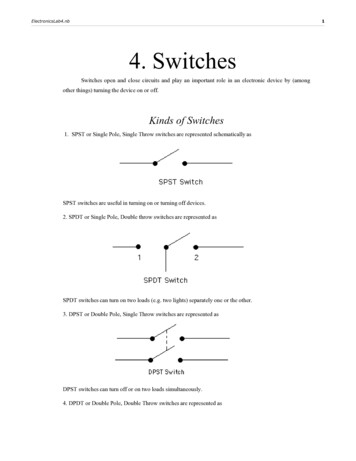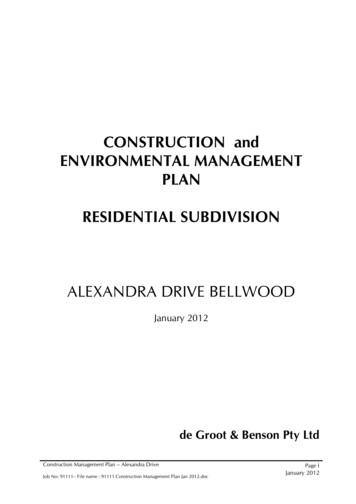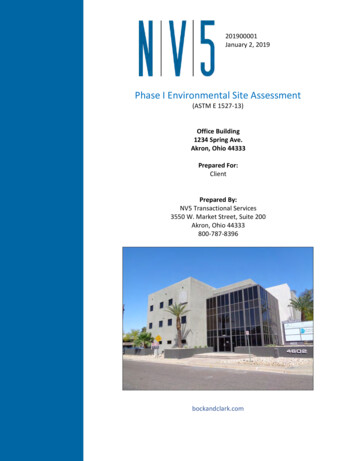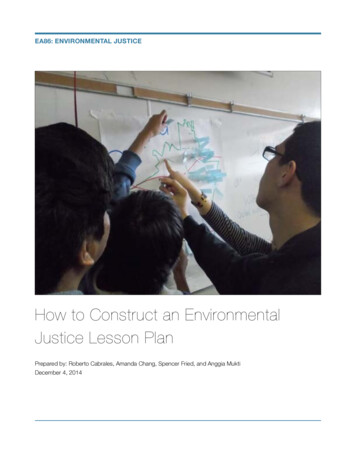
Transcription
EA86: ENVIRONMENTAL JUSTICEHow to Construct an EnvironmentalJustice Lesson Plan!Prepared by: Roberto Cabrales, Amanda Chang, Spencer Fried, and Anggia MuktiDecember 4, 2014
Table of ContentsThe Importance of Environmental Justice Education . . 2Know Your Audience . . . 4What are Your Goals? . . . . 6How to Engage the Students . . . . . 7Going with the Flow- - Modifying your Lesson Plan . . 10Evolution of a Lesson Plan . . 12Things to Consider . 18Appendix A: Toxic Tour PowerPoint . 19Appendix B: Maps . . 361
THE IMPORTANCE OF ENVIRONMENTAL EDUCATIONEvery day there are increasing threats to our environment, but who is being taught aboutthese dangers and what dangers are being taught? In magazines and newspapers, thecentral focus is on the threat of climate change or deforestation, but tend to display pictures ofmegafauna as the major victim.Figure 1. Time magazine cover from April 3, 2006As a result, environmentalism has a reputation of focusing on wildlife more than people;; butthe threats of climate change and pollution adversely affect humans and animals, although wedo not always realize how they affect us. We live busy lives and, whether it is tending to ourjobs, schoolwork, families, or friends, we are preoccupied. Understandably, most people donot have time to think about the consequences of our deteriorating environment, especiallywhen the consequences reveal themselves so slowly. Often we do not recognizeenvironmental injustices until they come to our neighborhood and by then it can be too late.As we carry on with our day- to- day routines, events take place unbeknownst to us thatimpose harmful effects upon our health. In many of our communities, we have seen a gradualincrease in the number of cargo trucks, warehouses, factories, and waste facilities thatcontaminate the places we call home. It seems that we have no say in what goes in ourcommunity and it all occurred behind our backs. We start to see signs indicating that a park isno longer suitable for child’s play because of its proximity to a warehouse or factory. Wereceive notice from the city to be careful about drinking water that comes out of our kitchenfaucets. We receive calls from doctors alerting us that our child has a case of asthma that isof growing concern. Or we get sat down by a loved one to be told that they have just beendiagnosed with cancer. This occurs because certain industry leaders and politicians, with2
profit as the motive, have exploited our landscapes. They have carried out injustices upon theenvironment- - and in doing so, upon us as well.But we ask ourselves in the midst of all this injury, what exactly happened? How long have wenot known? What were the causes of all these mishaps? Why were we not notified? Who canbe deemed responsible? These questions do not have a straightforward answer, but theymust be addressed. We can reflect on these events and make it a mission to see that theseinjustices do not happen elsewhere. We can start to shift the environmental movement fromNot In My Backyard (NIMBYism) to Not In Anyone’s Backyard. We can create a balance inthe environmental movement between wildlife and people. Instead of choosing one or theother, we must accept that humans are part of the environment. When you ask someone,“What words do you associate with ‘environment,’” very rarely will they say “people.”However, people are both the culprit and victim amid environmental injustice. But alsohumans are the solution. In order to address environmental injustices we must accept that wehave a responsibility and share this information to others. This is a call to arms requestingpeople to cultivate an awareness of the growing environmental justice movement;; the beststart to do this is through community education. This guide aims to assist community activistsin stimulating curiosity, raising concern, and inspiring action among the youth.3
KNOW YOUR AUDIENCEIt is important to know your audience when giving a presentation. The activities you use willdiffer depending on your audience. Furthermore, it is always easier to teach if you can relateto your audience and their experiences. You will not always have the right background toappeal to your audience, but this is an opportunity to ask or recruit others to help you to do so.Even if you are knowledgeable in environmental justice, someone from the community youare teaching will have valuable insights to help you. You may be the teacher, but this is alsoan opportunity to be a student!For example, our group of college students worked with high school seniors at Pomona High,the underfunded local public school in the north- side neighborhoods of Pomona- - alow- income city that is predominantly Hispanic and black . We recognized that we had to haveengaging and fun activities for a young audience. As college students, we had a greateropportunity to relate our presentation back to the high school students. Amanda Chang, beinga traditional- aged college student, provided a generation- bridge that allowed us to connect toour youth audience. We wanted the students to connect with our topic by showing howenvironmental justice is especially relevant for them. We wanted to bring awareness to theenvironmental injustices they may not realize they face daily. We were lucky to have AnggiaMukti, a Pomona High alumnus, and Roberto Cabrales, an environmental justice activistaffiliated with Communities for a Better Environment (CBE), as part of our student group. Wealso partnered with United Voices of Pomona (UVOP) who linked us to Ali Hangan, a teacherthat asked UVOP to give a presentation to his classes: two Economics classes and oneAdvanced Placement Government class.Our student group drafted a lesson plan that we believed would engage the students. Wewere not certain what the students would be like, but we recognized that the students in thatcommunity, though they would all be intelligent and thoughtful, may not have manyopportunity to offer their voices. Thus, we intended to create a space that provided thisopportunity. “Step Up Exercise” (See Figure 2.), we knew, would accommodate this goal. Wegave statements and students would step up (or raise their hand) if they related to thestatement. For example, we asked students to step up if they or someone in their family hasasthma, or to step up if they or someone in their family have cancer or is a cancer survivor.We were especially hopeful that the AP class would be receptive of our lesson. Whileteaching the classes, it was clear that all the students were smart, though some were morevocal than others.This activity not only engaged the students, but also connected them to theissue as a shared experience with their peers .Knowing how to communicate with your audience is also important. For one of thestatements, “Step up if you or your family would move residences if they could afford to moveright now,” the students were initially confused as to what was being asked. However, onceAnggia restated the question, “How many of you have heard your parents say your family willmove out of Pomona once they get enough money or have had friends ‘escape’ Pomona High4
to another public high school?” hands shot up immediately. Knowing your audience andknowing how to frame questions will make your lesson plan stronger.Figure 2. Roberto Cabrales conducting the Step Up exercise with Pomona High School seniorsGetting advice from people from the community gives your lesson more legitimacy. Peoplecan be wary of outsiders telling them what to do or how to think, but if they see someone theycan relate to they are more likely to open up and enjoy the discussion. In our experience, italso helped that our instructors were people of color so when we posed questions about raceto an almost completely non- white audience, the students were pretty receptive andresponsive. This is not to say that white or affluent people cannot teach issues of race orclass to these communities, but rather these instructors must be aware of their privilege andrecognize that they are not the experts. Instead of lecturing or teaching, they must give thecommunity members the space to teach their experiences.In relating to any community, the most important part is to have fun with them! This isimportant in all lesson plans, but especially true for children and young adults. Your studentswon’t always be younger than you but you should still make an effort to make the lessonentertaining. No one wants to sit through a boring presentation with people talking down tothem. To make a lesson plan successful, treat your students as equals and not as ignorant oruninformed students. The best way to do this is to present your students with information andleave to them to interpret what this information means. Of course, you can nudge theconversation certain ways or ask structuring questions, but the best lesson plans allow theaudience to reflect and think for themselves. Knowing your audience also means trustingthem to be receptive of your lesson plan. After all, you formulated it specifically for them.5
WHAT ARE YOUR GOALS?Before you can formulate a lesson plan, you need to know what you want as the end result ofthe lesson plan. Do you want to create foundational knowledge? Do you want to introducecontroversial concepts? Do you want to have your students to follow up your lesson withanother assignment? Once you decide on your goals, you can construct your lesson planaround them.Our group developed the following goals before constructing our lesson plan for Pomona HighSchool. We wanted the students:1. To understand the basic concept of Environmental Justice (and how it differs from“mainstream” environmentalism)2. To learn about what is going on in the community3. To feel inspired to become active in the community4. To learn about ways to resist (environmental) injustices in the communityAfter conducting your lesson plan, you can go back and see if you’ve fulfilled your goals. Youmight fulfill them to varying degrees or even fulfill goals you didn’t consider. Writing down yourgoals will give your lesson plan more direction while also giving you the opportunity to furtherdevelop your lesson plan. You can find better ways to teach your goals. You can find a newset of goals that build off your original goals and make a follow- up lesson plan for the samegroup of students. Goals can also ensure that you are leaving each lesson knowing you leftthe students with constructive knowledge. The best goals are the ones tailored to the targetaudience.6
HOW TO ENGAGE STUDENTSWe have detailed some activities in this guide. This section has a comprehensive list ofpotential environmental justice education activities that can be mixed and match to best reachand engage your audience.Mapping Exercise: Are You Living in a Toxic Area?This exercise is aimed for audiences that live in a known toxic area so you can relate yourpresentation and lesson back to them. For this exercise, you will need small sticky notes aswell as a map of the area your audience lives in. This can be a road map, a rough sketch, or aGIS map. As long as you include the major streets and freeways on the map, your studentsshould be able to navigate the map.Ask students to write their names on sticky notes. Put the map on the board or on a wall andask your students to place their sticky note on the general area of residence (See Figure 3).Depending on how detailed your map is, students should be able to find the exact location oftheir residence. Otherwise, a general sense of where they live is also effective.After students have located their neighborhoods on the map, show them the toxic sites in theirarea on a different map. This can be done by passing around a smaller map with the toxicsites or by projecting the toxic sites onto the map with their sticky notes. The second methodwould require more preparation and technology, though it would be ideal.7
Figure 3. Roberto Cabrales holds up completed mapMove the Power Exercise:For this exercise you will need a rug and two or three instructors.Lay the rug out and have the instructors sit on the rug. The instructors on the rug representthe current power structure of government leaders or industry officials. Ask for one volunteerto attempt to pull out the rug out from under all of you. He/she represents a concerned citizen.It may take a little bit to get the first volunteer, but after that person tries a few times, ask foranother volunteer to help. Keep asking for volunteers until students are able to pull the rug outfrom under the power structure.This exercise shows that a group of people have more power to move the existing powerstructure. More importantly, you will also notice that people are more eager to volunteer oncethey see their peers or friends struggling to move the rug. This is an example of how peopleare willing to rally around someone they see taking action (See Figure 4).Figure 4. Amanda Chang, Anggia Mukti, and Roberto Cabrales conducting Move the Power exercise with somePomona High School seniorsStep Up Exercise:Ask your audience to step up or raise their hand if the following statements are true for them.1. Step up if you or someone in your family has asthma2. Step up if you or someone in your family is a cancer survivor or has died from cancer3. Step up if you live within a mile of a Freeway8
4. Step up if you often have to close your windows because there are foul smells in yourneighborhood. (Note: If not many people raise their hand or step up, point out that theymight have gotten used to the smell after living there for so long or for their whole life)5. Step up if you live within a mile of a Gas Station6. Step up if your family would move to a different neighborhood if they had the money.After each statement, give people a few seconds to look around and take in the responses oftheir peers. The students can stand to form a large circle for this exercise, stepping closer tothe center with every statement they agree with. If the classroom space is limited, however,raising their hands will also work.Word Association: “Environment” and “Justice”Write down the words “Environment” and “Justice” on the board.First ask your audience to shout out words and ideas they associate with “environment.” Thenask them to shout out words and ideas they associate with “justice.” These can be definitions,perceptions, or words they think of when they hear environment or justice. Write down allanswers even if some of them are silly. There are no wrong answers! (See Figure 5). Theanswers will give the instructors a deeper insight into the community they are reaching, whichin turn will help the instructors in facilitating a better learning experience for everyone.Figure 5. Word Association Exercise results9
GOING WITH THE FLOW- - MODIFYING YOUR LESSON PLANHaving a well- prepared lesson plan is crucial to the success of a presentation. However,presenters must recognize that to follow a lesson plan perfectly is nearly impossible. Severalfactors that should be kept in mind before and DURING a presentation are: time, resources,and audience.TimePrior to a scheduled presentation, you should know the time allowance for your lesson. Beforeour presentation at Pomona High School, we were told that each class period was 50 minuteslong. We were instructed to plan a 40- 45 minute presentation for each session. With thatinformation, we created a lesson plan with specific time frame for each activity.However, we soon found that the class teacher required nearly 15 minutes from each classsession to complete his teaching agenda (some were unrelated to our presentation). Thus, wewere left with approximately 30- 35 minutes each period to give our full presentation. For thisreason, we had to adjust the structure of our lesson plan, mostly combining some of theactivities that were comparable to each other. For example, we passed out several TRI mapsaround the classroom while the students took turn to mark their neighborhoods on the largemap of Pomona. We were also able to shorten the “Toxic Tour” Power Point in order toensure the wholeness of the rest of the presentation. As such, be mindful that although youmight expect a certain time allowance, you must anticipate and be prepared to shorten and/oralter your presentation without jeopardizing the content.ResourcesPreparing a lesson plan entails knowing what props you will need. This is perhaps the mostcontrollable part of a lesson plan. Even so, it is important to realize that some classrooms maynot be able to accommodate all the activities you designed or the props you intend to use.We initially planned to put up several maps of Pomona around the classroom to allowstudents to study them. However, the set up of the classroom was not compatible with thisactivity: the desk rows filled the room so that the students would find difficulty in maneuveringthemselves between desks to move from one map to another. Instead, we passed around themap, which in turn also gave us more time for our presentation. Another adjustment we madewas the “Step Up” Exercise. Because of the limited space in the classroom, we could not agather the group in a circle to perform the exercise. Rather, we asked the students to raisetheir hands at each prompt.Although not being able to use your props or execute an exercise as planned can be quitedisappointing, sometimes unexpected available resource ends up being the best part of your10
presentation. Our very experienced tour guide, Roberto, saw that the classroom had an arearug conveniently laid out in front. He immediately thought to utilize the rug, with permissionfrom the teacher, for an unplanned activity: “Move the Power Structure.” According to thepost- presentation survey conducted at the end of each session, this activity consistentlytopped the chart as the students’ favorite activity.AudienceThe audience is the most important and arbitrary component of any presentation. Frommultiple groups, you will have varying dynamics. Knowing the demographics of your audiencewill certainly be helpful in preparing your lesson plan. For example, we knew that we would begoing to Pomona High School: most students there are from lower- income, non- whitefamilies. Although this information was valuable, statistics only provide a generalized idea ofthe audience. We found that each classroom offered a different energy and chemistry, eachstudent’s personality contributing to the character of the group.The first class was earlier in the morning;; the students were very attentive and eager to startthe day. With this group, we found that they were very interested in seeing theirneighborhoods in the different maps. To engage this interest, we dedicated more time instudying and discussing the maps, while relating them to their relevance to environmentaljustice issues in Pomona.The second session was held later in the morning, the class period before the school’s firstbreak of the day. We expected the students to be somewhat antsy, ready to take a break frombeing cooped up in a stuffy classroom. The group proved to be quite energetic and mosttalkative. With this group, we recognized it would be beneficial to channel their energytowards a discussion- heavy presentation. The group was highly interactive with our “WordAssociation” segment and “Step Up” Exercise. The group brought great ideas into ourdiscussion, allowing us to see more of them as individuals. With this group, more time werespent on an open discussion.The last presentation was to an AP Government class. This group, quite obviously, was the“serious scholars” of the bunch. The students were more familiar with the “academic” contentsof our presentation than the two previous groups. This allowed us to follow our original lessonplan more closely, with a heavier focus on how to get involved in the community.Going with the flowRecognizing the three factors together will help you to produce a natural and fluidpresentation. By recognizing logistical challenges in your presentation and using youraudience as a biometer, you can successfully adjust your lesson plan to accommodate eachsituation. Spontaneity will make every presentation a one- of- a- kind and memorableexperience for all involved. In summation, a lesson plan should not be looked at as a bindingcontract;; rather, it should be viewed as a flexible guide to your presentation.11
EVOLUTION OF A LESSON PLANThe following lesson plans are our different phases of lesson plan development for PomonaHigh School. Please refer to the appendices to see some of the resources we used during ourpresentation, such as the Toxic Tour Presentation and the GIS map drafts.Phase One: Pre- PresentationGOALS: Familiarity with the EJ movement (and how it is different from mainstreamenvironmentalism that they may have preconceived ideas about) What are they passionate about? What can they do about it? Learn about ways that they can resist injustice in their own community, and whatothers are already doing.AGENDA:1.As they walk into the classroom have them put their place of residence on the map (3min)2.Explain who we are (3 min)3.Write down on the board the two words: Environment and Justice3.1.What do you associate with these words? (7 min)4.Pre- presentation assessment (post it notes) (2 min)4.1.How relevant is environmentalism to your life?5.Toxic Tour Powerpoint (15 min)6.Step Up exercise (5 min)6.1.Step up if you or someone in your family has asthma6.2.Step up if you or someone in your family is a cancer survivor or has died fromcancer6.3.Step up if you live within a mile of a Freeway6.4.Step up if you often times have to close your windows because there are foulsmells in your neighborhood.6.5.Step up if you live within a mile of a Gas Station6.6.Step up if you or your family would move residences if they could afford tomove right now.7.Post- presentation assessment (would you change your answers from before?) (2 min)8.Small groups (6- 7 people to a group): What did you learn from this presentation thatyou didn’t know before, structured questions, addressing their lack of informationabout the toxic sites in their community (brainstorm questions below) (5 min)12
8.1.What can they do? Emphasize the power that they as community membershave;; e.g. voting, organizing8.2.What action are people taking to protest or resist in your neighborhood?9.Back to the entire class, have a larger discussion, get a feel of the room and if they aremore engaged have them lead their own discussion and if not have structuredquestions (brainstorm questions below) (10 min)9.1.What did they learn today that they didn’t know before?9.2.What is environmental justice?10.Try to put in a national/global perspective, success stories10.1.Empower them! How do they get involved?Evaluation Questions:1. What was your favorite part of the presentation?2. What was your least favorite part of the presentation?3. What’s a question you have?Phase Two: Executed Lesson PlanThis curriculum is intended to give high school students an overview and introduction toenvironmental justice.GOALS for the students: To understand the basic concept of Environmental Justice (and how it differs from“mainstream” environmentalism) To learn about what is going on in the community To feel inspired to become active in the community To learn about ways to resist (environmental) injustices in the communityAGENDA:1. Write down on the board the two words: Environment and Justice1. What do you associate with these words?2. Pre- presentation assessment1. How relevant is environmentalism to your life?2. What does an environmentalist look like?3. The Environmental Justice Movementa. People Huggersb. Tree Huggers3. Place a sticky- note on the map of where you live4. Pass out maps of pollution distribution in Pomona and surrounding areas5. Pull up Toxic Release Inventory (TRI) map (of Pomona and surrounding areas) on theprojector13
6. Toxic Tour Powerpoint from United Voices of Pomona representative (10 min)7. Step Up exercise1. Step up if you or someone in your family has asthma2. Step up if you or someone in your family is a cancer survivor or if you knowsomeone who died from cancer3. Step up if you live within a mile of a Freeway4. Step up if you often times have to close your windows because there are foulsmells in your neighborhood.5. Step up if you live within a mile of a Gas Station6. Step up if you or your family would move residences if they could afford tomove right now.8. What are toxic materials?1. Mobile source pollution2. Prop 65 (Chemicals known to cause cancer, birth defects, etc.)9. What did you learn from this presentation that you didn’t know before, structuredquestions, addressing their lack of information about the toxic sites in their community(brainstorm questions below)1. What can they do? Emphasize the power that they, as community membershave (e.g., voting, organizing)2. What action are people taking to protest or resist in your neighborhood?a. United Voices of Pomonab.City Hall meetings10. Try to put in a national/global perspective, success stories1. Empower them! How do they get involved?a. Provide sources (storyofstuff.org, etc.)b. United Voices of Pomona11. Closing Activity Move the Rug12. Presentation Assessment (Plus/Delta)1. Evaluation Questions:a. What was your favorite part of the presentation?b. What was your least favorite part?c. What questions do you have?Phase Three: Post- Presentation (Ideal) Lesson PlanEnvironmental Justice 101This curriculum is intended to give high school students a brief overview and introduction toenvironmental justice. This lesson plan includes concepts of popular educ
conversation certain ways or ask structuring questions, but the llboews t th lesson plans a audience to reflect and think for themselves. Knowing your audience also means trusting them to be receptive of your lesson p

